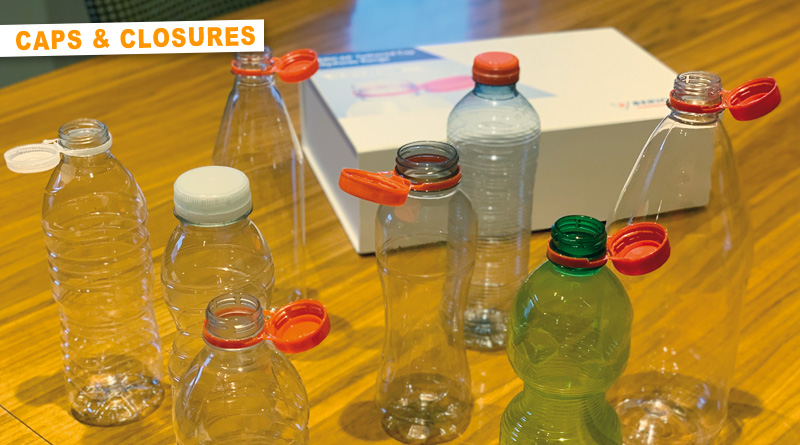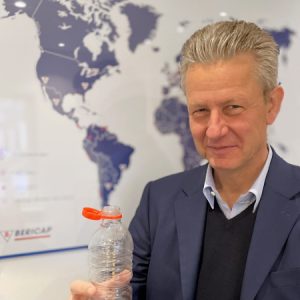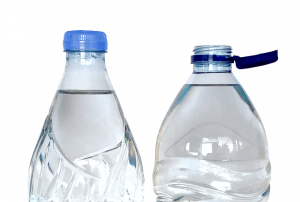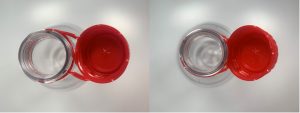Consumer convenience with ClipAside
Tethered caps will have to be used for disposable beverage containers up to 3 litres in the EU from 2024. Two years ago, we discussed a number of potential options. Today, the industry’s solutions seem to be caps that can be moved to the side on straps or with a hinge. We spoke to Alexander Krautkrämer, CEO of Bericap, about the current situation.
PETplanet: Mr Krautkrämer, two years ago, we were sitting at this very table discussing the EU Single Use Plastics (SUP) Directive and what it would mean for the PET bottle cap. What has happened in the meantime?
Krautkrämer: Our main focus two years ago was on developing and evaluating a number of ideas for a tethered cap. We also discussed whether new neck geometries would be needed, or if such a cap could be produced using existing neck geometries.
PETplanet: Today, we are seeing the first designs appearing on the market: among the examples on the table we also see your ClipAside design on a 1.5 l OGEU water bottle for the French market. How did you get there?
Krautkrämer: We spent a lot of time searching for a closure design that was both intuitive and convenient for the consumer as well as safe for the bottler to process on existing machinery. We finally decided on a licensed solution from ThisCap. The ClipAside closure can be handled easily without the consumer ever having opened a tethered cap before. We can manufacture the cap by slitting along the tamper band. We produced a sample run of 70 million, which was very satisfying. Furthermore, the ClipAside design convinced us with its consistent performance (e.g. opening angle) on all relevant neck finishes ranging from 26-38 mm. We are currently supplying ClipAside for 29/25 and 38 mm 3-start neck finish, and will start serial productions also for PCO 1881, GME 30.40 and 38 mm 2-start within the next two months.
PETplanet: In what way is this different from other tethered solutions on the market?
Krautkrämer: We will see different designs and the market will decide which of these will prevail. There will be moulded and slit tethers, interferent and folded bands as well as solutions with and without protrusion. One advantage of ClipAside lies in the design of the straps that hold the cap in place. Our ClipAside model has parallel tethering straps.
The parallel tethering straps give the cap more play, which means that the consumer cannot “overstretch” the cap when pushing it to the side. Even when pushed over at an angle of 180° to the bottle shoulder, the cap will spring back into an 180° position. Overstretching with trapezoidal tethers tends to break the tethers; hence one of the significant differences is not moulded versus slit, but it is parallel versus tethers under stress.
The other big advantage for our customers is the flexibility of the slitting process. The new closure shell can of course be slit with standard or tethered slit. Which means: our customers can already today qualify and test their filling lines with the new closure design including a standard slit. Once they are ready for the market introduction with tethered caps, it is only a change in the slitting geometry which then does not require any further modification on the filling equipment.
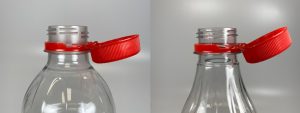
PETplanet: For 1881 neck finishes you are claiming an opening angle for ClipAside within a range of 160-180° whereas the new tethered cap on the OGEU bottle fixes nicely at an 180° angle. Shouldn’t the 180° opening angle be the objective?
Krautkrämer: This is due to the neck support ring (NSR) diameter. Most current 1881 necks in the market are using a very wide neck ring diameter of 33 mm. The cap then touches the ring when opened and can only be fixed at an angle of 160°. We recommend using neck support ring diameters of 31 mm or even as low as 29 mm as these neck support rings do not interfere with a 180° opening angle. You can see how well this works on an OGEU bottle which has this smaller neck ring. (Pictures above) And by the way, the smaller neck support ring also allows further weight reduction in the bottle neck.
PETplanet: Which brings us to the neck geometry. Does the bottler have to switch to new geometries?
Krautkrämer: This always has to be checked on a case-by-case basis. Bottlers can continue to use their neck finishes currently in use even though we highly recommend to reduce the neck support ring diameter. Nevertheless the new CSD neck GME 30.40 has been developed and is in the stage of market introduction. Compared to PCO 1881 neck finishes, GME 30.40 provides a weight saving for neck and closure of 1.4 g for NSR 33 mm and even 1.61 g for NSR 30 mm. But, of course, I have to consider a bottler’s whole production system, can he/she make step-by-step changes, do they have to switch several lines at the same time etc.? As I said, there is no general answer.
PETplanet: You said that the ClipAside is a ThisCap idea and that you have a licence to use it. Does that mean that other cap producers can also obtain a licence?
Krautkrämer: Yes, and I think that is a good thing. Ideally one but no more than three technologies have to become established at large scale in our market so that we are able to produce the necessary unit quantities. In my view, it does not make sense to have a hundred different alternatives. Just providing the ClipAside for all neck sizes from 26-38 mm involves a huge amount of effort and investment. We have already qualified and introduced the ClipAside for the PET 26 (GME 30.40), PCO 1881, PET 29/25 and PET 38 2- and 3-start. We can also supply samples for the PET 26/1-and 3 start, PCO 1810, PET 33-2 start and the Snap-on PET 26/10. We are well prepared to support our customers with large volume line trials and accompany them through the qualification and introduction process.
PETplanet: Thank you very much, Mr Krautkrämer!

